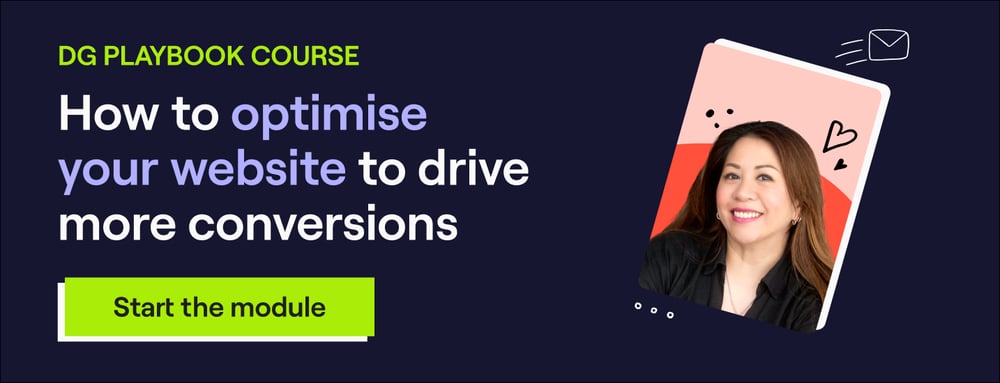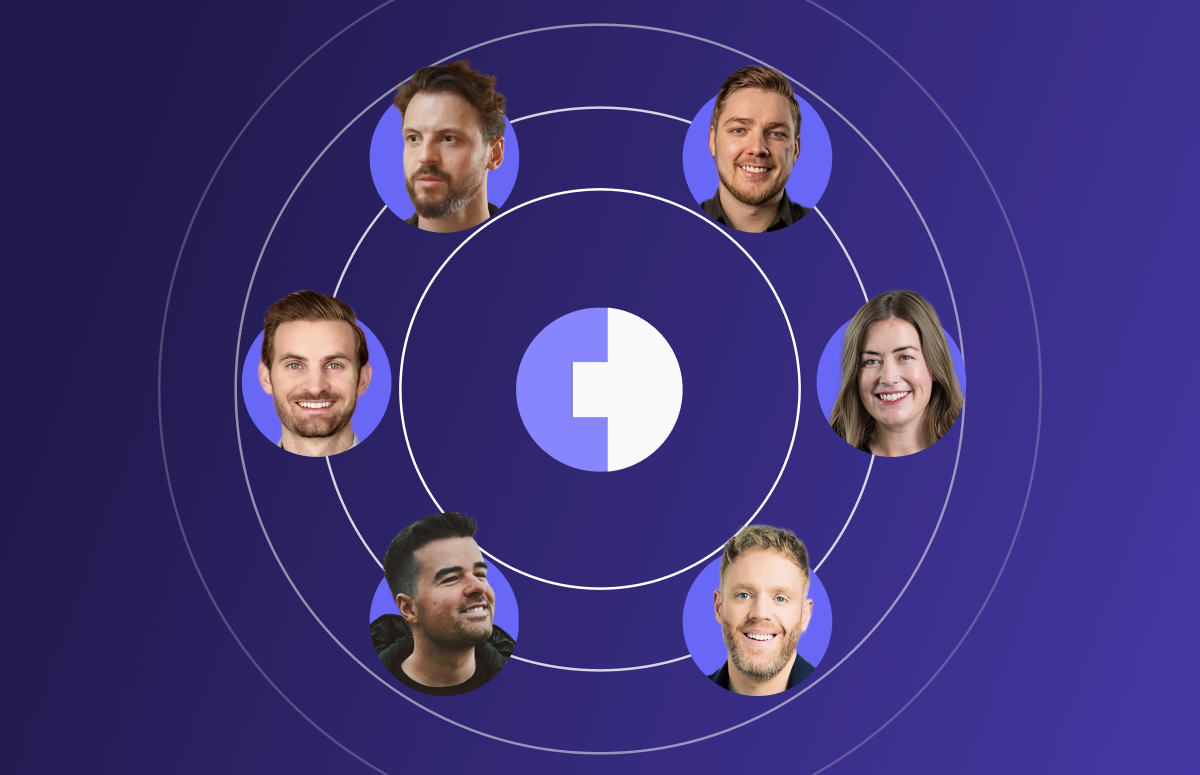12 Website Conversion Rate Optimisation Tests You Can Steal
12 CRO tests:
If you want more demo conversions without more traffic, copy what already works.
Below are the experiments we ran, the changes we made, the results, and why they worked, so you can replicate with confidence.
1. SDR Zone: Outcome-led hero + 3-step learning path
SDR Zone is a content hub designed for SDRs to find the vital insights and coaching help they need to be successful in their roles.
The original page opened with generic copy and competing CTAs, so we refocused the hero on outcomes (“Book more meetings, not just make more calls”) and introduced a simple, guided path.
We handpicked 3 essential SDR resources to help visitors know exactly where to start - reducing overwhelm and kick-starting their learning journey with the highest-impact content. Progress cues and scroll triggers nudged visitors through the flow without extra friction.
Results:
- Session length: +267%
- Bounce rate: –79%
- Pages per session: +33%
Why it worked:
Reframing the hero around results made the value obvious, and the clear 3-step path matched how SDRs naturally evaluate: understand → visualise → try.
It turned a static page into a guided journey that kept problem-aware users engaged and moved them closer to conversion.
2. SEO blog CTAs: Banner beats button
Our SEO blogs were performing well in terms of traffic, but converting poorly.
The culprit? Tiny, easily-missed CTAs tucked at the end of posts.
We tested a banner-style CTA that spanned the entire page, was visually prominent, mobile-friendly, and positioned halfway through the article where readers were most engaged.
The banner copy was outcome-focused (“Get a free B2B data sample”) rather than product-first (“Book a demo”), and it used a strong contrasting colour to separate it from the content without feeling like an ad.
We also tested sticky placement to ensure the CTA remained visible as users scrolled.
Results:
- Conversion rate: +66% (1.94% → 3.23%).
- Session length: +158% (51s → 2m11s).
- Bounce rate: –78% (69.72% → 15.38%).
- Pages per session: +261% (1.70 → 6.13).
Why it worked:
The high-contrast banner reframed the CTA as part of the reading experience, rather than an interruption. It met visitors mid-intent, after they’d consumed value and were primed for a next step, which is when conversion intent peaks on educational content.
By pairing relevance (a free data sample connected to the blog topic) with constant visibility, we reduced the likelihood that engaged readers would drop off before taking action.
The result wasn’t just more conversions; users also explored the site more deeply, signalling stronger buying interest.
3. Exit-intent popups on data-sample pages
Visitors landing on our data sample pages were clearly showing evaluation intent. They’d scrolled, engaged, but then exited without taking action.
We wanted a way to re-engage those users before they disappeared.
So, we tested exit-intent popups that triggered as a user moved to close the tab or navigate away. The offers were simple and relevant:
- “Get Free Leads” - positioned as a limited-time offer.
- “Access a Free Data Sample” - aligned with the page topic.
Both popups were cleanly designed, with minimal copy, a single CTA button, and no extra friction (no lengthy forms or multiple fields).
Results:
- Free Leads popup CVR: 7.25% (from 0%).
- Data Sample popup CVR: 4.84% (from 0%).
Why it worked:
Exit-intent popups succeed when they add timing and value, not noise. These offers caught visitors right at the decision point. When interest was high, but commitment was uncertain, it reframed the interaction as low-risk and high-reward.
By using tangible, product-adjacent language (“Free Leads”) instead of generic CTAs (“Learn more”), we tapped into immediate curiosity and made it easy to say “yes.”
The result was a meaningful recovery of otherwise lost conversions, with a user experience that still felt helpful, not intrusive.
4. Cookie banner: Small design tweaks, big opt-in lift
Our cookie consent rates were lower than expected, and analytics data was being skewed as a result.
The banner itself wasn’t broken; it just wasn’t inviting. The text was small, the choices were vague, and the styling didn’t match the rest of our site’s clean, modern design.
Using CookieFirst, we redesigned the banner with subtle but meaningful UX tweaks:
- Increased font size and contrast for better readability.
- Simplified the microcopy to clarify what “accept” and “decline” actually meant.
- Adjusted button spacing and colour balance to improve scannability.
- Ensured the design aligned with Cognism’s brand styling, creating visual trust from the first interaction.
Results:
- Opt-in rate: +7.9%.
- Opt-out rate: –13.7%.
Why it worked:
Even minor friction at the very first touchpoint can hurt your analytics, remarketing, and conversion tracking.
By improving readability and transparency, we made the decision feel informed rather than forced.
Users were more comfortable opting in when the design looked trustworthy and the language felt human. This small design tweak improved data accuracy across the funnel and made a measurable impact on the health of all subsequent CRO tests.
5. Competitor pages: New template with trust elements
Our old “Cognism vs X” pages were dense and read like product docs. Visitors with strong comparison intent needed fast, credible answers - not paragraphs. We rebuilt the template around clarity + proof:
- Above-the-fold summary bar: one-sentence positioning (“More reachable, compliant B2B data”), a trust stat, and a primary CTA.
- Scannable comparison table: 6–8 decision criteria (coverage, direct dials, compliance, support, integrations, pricing model) with clear ticks, not marketing jargon.
- Evidence stack near every claim: case-study callouts, quantified outcomes, and G2 badges/ratings.
- Logo + quote wall: recognisable customers with short, outcome-led quotes (e.g., “+37% meetings in 60 days”).
- Sticky CTA on desktop and thumb-reach button on mobile to keep the next action visible.
- Objection handling section: short FAQs addressing pricing expectations, data sourcing, and compliance.
- Contextual CTAs by intent: “Get a data sample” for researchers, “Book a demo” for in-market buyers.
Results:
- Demo CVR: +38% to +167% across pages.
- Engagement: Pages/session up; bounce rate down (consistent lift across multiple competitor URLs).
Why it worked:
Comparison pages catch buyers at the highest intent outside pricing.
The new template reduces cognitive load with structured scannability (summary → table → proof) and backs every claim with immediate credibility signals (logos, ratings, quantified outcomes).
Pairing that with a persistent CTA removes friction.
6. Demo Centre UX: Put everything where users need it
Before this test, our demo experience was scattered across multiple pages - different Storylanes, product overviews, and CTA paths that made it hard for visitors to find the right entry point.
Buyers who wanted to see Cognism in action had to click between pages, which created friction and made tracking intent murky.
We consolidated everything into a single Demo Centre hub, a central page where visitors could:
- Watch interactive Storylane demos for each product area in one place.
- Easily navigate between different use cases (Sales, Marketing, RevOps) via tabs.
- Access a primary CTA to “Book a Live Demo” right beside each experience.
- See supporting content (case studies, short explainer videos, and testimonials) without leaving the page.
The goal was simple: reduce pogo-sticking (jumping back and forth between pages) and keep buyers evaluating within our ecosystem for longer.
Results:
- Time on page: +182%.
- Clicks through to demo page: +27.4%.
- Rolled out 100% across key product areas.
Why it worked:
When evaluation content is spread across multiple pages, visitors drop off mid-journey. Centralising it turns discovery into a guided flow, one page that answers “What is it?”, “How does it work?”, and “How do I try it?” in sequence.
It also aligns perfectly with self-serve buying behaviour. Letting prospects explore at their own pace while staying firmly in your “buying zone.”
By reducing clicks and increasing perceived control, customer engagement deepened, intent signals strengthened, and demo conversion improved.
7. Sticky CTA on high-intent pages
On high-intent pages, such as Pricing, Competitor Comparisons, and Product Overviews, our heatmaps revealed a simple truth: visitors scrolled deep but rarely returned to click the main “Book a demo” CTA.
The intent was there, but the CTA visibility wasn’t.
To fix that, we added a persistent sticky banner that stayed anchored to the bottom of the screen on both desktop and mobile. The design was clean and on-brand, with a Cognism purple background, concise copy (“Book a demo”) and a subtle animation on hover.
For mobile, we made sure the banner sat comfortably within thumb reach, without overlapping content or feeling intrusive.
Results:
- +41 additional leads during the test, which resulted in a +18% uplift in demo CVR post rollout.
- Consistent improvement in CTA click-through rates and page→demo conversion.
Why it worked:
Visibility beats memory. High-intent visitors shouldn’t have to remember where your CTA was - it should follow them as they read, ready when they’re ready.
By removing the “scroll back up” tax, we captured intent at the exact moment of readiness.
The persistent CTA also created a subtle sense of momentum - as users progressed through the page and their conviction grew, the next step was always right there.
8. CTA copy on SEO posts: Offer the sample, not the demo
On educational SEO posts, we A/B tested the CTA “Get a data sample” against “Book a demo.” Placement and styling stayed constant; only the copy changed.
The goal was to match the reader’s stage (problem/solution-aware, not yet vendor-ready) with a lower-commitment next step that still moves them into product evaluation.
Results:
- The “Get a data sample” CTA significantly outperformed “Book a demo” on the primary conversion metric (CVR). Hypothesis validated; marked as a win.
Why it worked:
Cold SEO traffic comes to learn, not to schedule. A product-adjacent, zero-pressure value step (“see real data you can use”) bridges the gap between learning and buying. It reduces perceived risk, proves relevance, and earns the right to ask for a meeting later.
9. Homepage hero media: Interactive demo > animation
Our homepage hero previously featured a polished product animation, which was visually appealing but slow to load.
We replaced it with an interactive Storylane that lets MM+ buyers click through a few key jobs-to-be-done (find ICP accounts, get verified mobiles, push to CRM) directly in the hero.
The first step is preloaded, so users can interact in one click without reading instructions. We kept a clear primary CTA (“Book a demo”) beside the experience and added a secondary “Get a data sample” link for lower-commitment evaluators.
Results:
- CVR: +27%.
- Broader engagement lifts (longer dwell, higher scroll depth, more clicks into product pages).
- Rolled out 100% across the homepage hero.
Why it worked:
Interactivity compresses evaluation. Instead of passively watching an animation, buyers do the thing they care about and receive instant proof.
That fast feedback loop builds belief faster, especially for MM+ visitors who arrive with a defined job and limited patience.
10. Homepage messaging for mid-market
Our homepage had historically leaned enterprise, meaning our messaging focused on scale, compliance, and complex integrations.
But our data showed that mid-market (MM) visitors comprised the majority of traffic, and their needs were different. They cared about getting results fast, not navigating a long implementation cycle.
So we tailored the hero copy, visuals, and supporting proof specifically for the MM segment.
- The hero headline shifted from enterprise-scale language to a faster, more outcome-led promise: “Find and connect with your next 100 customers, faster.”
- Subcopy reinforced speed and ease rather than infrastructure: “Verified B2B data, direct dials, and compliance built in, so your team spends less time searching and more time selling.”
- We simplified the social proof bar, showcasing well-known MM customers rather than global enterprises, to increase perceived relatability.
- The primary CTA remained “Book a demo,” but we introduced a secondary option, “Get a data sample,” for visitors who were not yet ready to commit.
Results:
- Consistent CVR uplift across six weeks, peaking at +777%.
- Engagement metrics up across all tracked sessions.
- Rolled out 100% sitewide.
Why it worked:
Segment-fit messaging is one of the simplest, most powerful CRO levers.
By adjusting tone and value framing to fit mid-market priorities - fast ROI, usability, self-serve evaluation - visitors instantly recognised themselves in the story.
It replaced the subtle “this isn’t for me” friction with confidence and relevance. The sharper promise and relatable proof meant buyers didn’t have to translate enterprise benefits into their world; they could see how Cognism fits their size and stage.
11. Social proof design that actually converts
Our existing testimonial section looked beautiful - branded gradients, stylised headshots, and abstract quote shapes.
But when we reviewed scroll and click data, most visitors weren’t engaging with it. The design drew attention, but the substance was getting lost.
We rebuilt the section using a simplified, stat-led quote card format that prioritised clarity over polish:
- Clean white background with large, bold metrics (e.g. “+37% more meetings in 60 days”).
- Short, authentic customer quotes beneath, limited to two lines max.
- Logo-first layout so readers immediately recognised credible peers.
- Removed decorative shapes and gradients to keep focus on the data, not the design.
- Added a contextual CTA (“See how they did it →”) linking to full case studies.
Results:
- +67% conversion lift from pages featuring the new proof cards.
- –64% bounce rate compared to the previous stylised version.
- Significant improvement in scroll depth and CTA clicks.
Why it worked:
Proof > polish. In B2B, visitors are scanning for signals of trust, not art direction.
The simplified cards made the value story instantly legible - metric → quote → logo — and allowed readers to process credibility in under three seconds.
By stripping away design clutter, the eye naturally lands on the result, which is what triggers curiosity and action. The stat-backed proof also reinforced consistency between message and evidence, helping buyers connect “what Cognism says” with “what customers get.”
12. Pipeline push sidepop
On high-intent pages for mid-market and enterprise (MM+/ENT) visitors, we added a subtle but high-visibility sidepop CTA designed to reignite engagement mid-scroll.
The message leaned into urgency and value:
“Get Free Leads Today”, appearing as a small, slide-in prompt once users reached ~60% of the page.
The design intentionally mimicked a conversational nudge rather than a pop-up ad: compact size, Cognism’s purple gradient, minimal text, and a single primary CTA.
Importantly, it was timed to appear only once per session and only for visitors showing engaged behaviour (scroll depth + time-on-page threshold).
Results:
- 44 CTA clicks across the initial test period.
- 1.73% CTR overall.
- Rolled out 100% across MM+/ENT pages for sustained engagement impact.
Why it worked:
The sidepop acted like a well-timed sales assist, visible but not interruptive. It targeted users who were already showing intent signals and offered them a fast, tangible action (“Free Leads”) before they bounced.
Because it appeared contextually, after the visitor had already engaged with page content, it felt relevant, not pushy. The offer’s immediacy (“today”) tapped into micro-urgency, converting passive curiosity into active interaction.
CRO tests best practices
1. Proximity to the next best action
When the next step is always visible, conversion rates rise without new traffic. Sticky CTAs, mid-article banners, and timed sidepops keep momentum high and decision cost low.
- How it showed up: Sticky demo bars on pricing/comparison pages; mid-post banners on SEO; sidepops for MM+/ENT.
- Do this next: Add a persistent CTA to your top 5 bottom-funnel pages; insert a mid-article banner on your top 10 SEO posts.
- Measure: Page→demo CVR, CTA CTR, assisted conversions.
- Avoid: Overlapping CTAs, mobile obstruction, “one more thing” popups on load.
2. Segment-fit messaging
Relevance beats reach. Pages that speak to a specific segment’s pains, language, and proof points convert faster.
- How it showed up: MM-specific homepage promise; comparison pages with criteria buyers actually use; different CTAs for research vs. decision visitors.
- Do this next: Map homepage hero + social proof to MM first; standardise comparison tables (same 6–8 criteria across vendors).
- Measure: Segment CVR, bounce rate by segment, return visitor CVR.
- Avoid: Generic benefits, enterprise logos for MM traffic, mixing “sample” and “demo” intents on the same fold.
3. Value before commitment
Offer a low-friction win that proves you can help before asking for a meeting. It shrinks perceived risk and accelerates evaluation.
- How it showed up: “Get a data sample” beating “Book a demo”; interactive Storylane in the hero; exit-intent “Free Leads.”
- Do this next: Make “sample” the default CTA on educational SEO; add a 2–3 step interactive flow to the homepage hero.
- Measure: Sample CVR, sample→demo rate (14–28 days), time on interactive blocks.
- Avoid: Long forms, vague freebies, gating everything.
4. Signal over style
Buyers scan for credibility cues, not art direction. Simple layouts that foreground outcomes, stats, and proof beat ornate treatments.
- How it showed up: Stat-led quote cards (+67% conv lift); cleaner cookie banner microcopy → higher opt-in.
- Do this next: Rebuild proof blocks: metric → two-line quote → recognisable logo → “See how” link. Refresh quarterly.
- Measure: Proof block CTR, fold-to-CTA conversion, consent rate.
- Avoid: Decorative noise, long quotes, outdated badges/case stats.


/SMB%20ABM/Blog_Image_How%20SMBs%20Can%20Run%20Enterprise-Level%20ABM%20on%20a%20Lean%20Budget%20%20Resource%20Card.webp)

